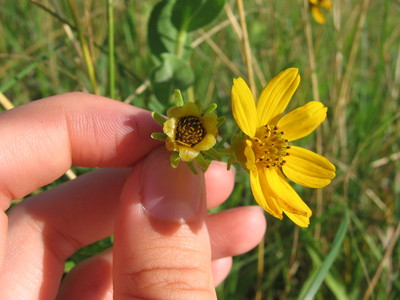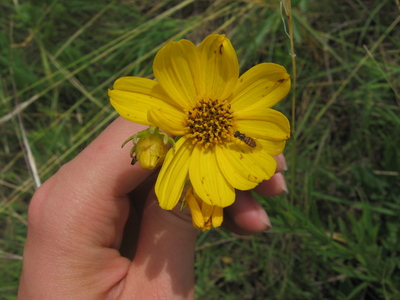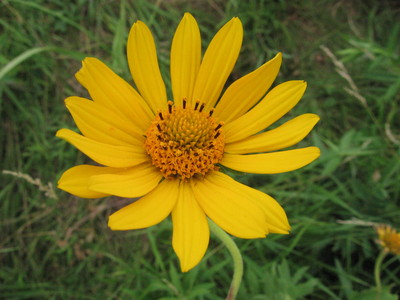|
|
The very damp morning began with flagging p8 on each nail that was spaced 1 m apart. A then very interesting meeting with Joe Montoyne from NCRS who provided us with much insight into prairie restoration and some local history of local prairies. After lunch Michael, Tracy, Andy and i wnet to p2 to harvest more flower heads. As the summer comes to an end i am so appreciative of the opportunity i have had this summer with the Echin Project and the group of quality young people here. Rest assured citizens, these kids will be our community leaders, parents and professors leading us into the next generation at a when the world needs such an intelligent thoughtful group in charge. I have also gained an appreciation for what we have been blessed with in our very own west central Minnesota. Everyone is within a few minute drive to a prairie with a diversity that may go unappreciated until you spend some quality time walking and observing what the prairie has to offer. Our zoo is right here. There is a diversity of plants and insects that will require thoughtful consideration of how we choose to treat the soil and water. It may be difficult to imagine that not too long ago west central Minnesota was acre after acre of prairie.
Hi all!
I’ve been back at Grinnell for about a month now, and so far my semester’s off to a great start! Very busy, but not busy enough to prevent me from finishing up my data analysis.
It looks like Echinacea purpurea‘s breeding system is similar to Echinacea angustifolia‘s. Styles that receive compatible pollen shrivel up within a few days, whereas styles that don’t persist longer, often for more than a week. In addition, E. purpurea is self-incompatible. (This means that an individual plant can’t pollinate itself, it needs pollen from another plant of the same species.)
To complicate things a little:
Not all of the flower heads I was studying had finished flowering by the time I left Minnesota, so I do not have much data on the top several rows of styles on many of them. Since styles in higher-up rows persist somewhat shorter than in lower rows, I cannot be sure that the trends I saw in my data hold for the top rows of all flower heads.
Also, some of the statistical tests I ran showed that style persistence in the self-pollination treatment differs significantly from the control treatment, while others do not. I’m not sure why that would be.
Here are my csv file and my analysis in R:
epurpurea.csv
epurpureaAnalysis.R
If anyone has any suggestions for improvement or other things I could look at with this data, please let me know!
And I posted much of my data analysis on H. helianthoides already, but here are the “final” versions. (But, again, I’m open to suggestions for further improvement!)
hhelianthoides.csv
FinalAnalysisLeeRodman.R
H. helianthoides appears to be self-incompatible. Here’s the data I collected:
hhelianthoides.csv
I’ve also started my data analysis in R. It’s not done yet, but here’s what I have so far:
Data Analysis.txt
Basically, styles persist significantly longer when self-pollinated or not pollinated than when cross-pollinated. However, in the top rows of florets on each flower head, style persistence does not differ as much between the treatments (because all the styles in these rows shrivel rather quickly). Therefore, when using style persistence to study other aspects of this species’ breeding system (ex. pollinator efficiency, compatibility of specific individuals), one should use the bottom several rows of florets. In these rows, cross-pollinated styles always shrivel within three days of pollen application, whereas styles that do not receive compatible pollen never shrivel so quickly.
As I mentioned before, I was unable to collect much quantitative data about C. palmata style persistence. But I did notice some things that might be helpful to anyone interested in studying this species further. The following document gives a brief summary:
C. palmata Summary.doc
My days of research at the landfill are coming to an end! I’ll be doing the last of my crosses there tomorrow and observing the results on Monday.
For the Coreopsis, I didn’t end up with much data about style persistence. Each head has about four rows of styles and dries up soon after it finishes flowering. Since I’ve only been visiting the landfill every three days, I didn’t get a chance to see what happened to most of the styles I pollinated before all the florets just turned black and fell off.
The good news is, I will be able to collected many of the flower heads I pollinated, so someone can assess their seed sets in the fall. (I was worried that when the florets fell off, they might have taken the seeds with them, but Stuart reassured me that the seeds are still there!)

I also have lots of data about Heliopsis style persistence. I’ll upload it here once I have the data in from my last few pollen crosses.
This past week a lot more Echinacea started flowering, which meant we had plenty to do. We located all the Echinacea plants in the Common Garden that will flower this year. There were so many! They seemed to be particularly abundant in the 99 garden.
We also completed some more aphid surveys for Katherine’s project, continued work on the New Media Initiative, and set insect traps for Greg’s project. I really enjoyed taking a quick peek at some of the insects that Greg’s traps caught. I don’t have tons of experience with insects, so I don’t know what genus any of them are yet, but some of them looked pretty nifty. I’m looking forward to finding out more about them.
My own independent project is coming along as well. I’ve been spending quite a bit of time this week working at the dump! For those of you who aren’t familiar with the prairie remnants we’re studying, I should clarify that I’m not actually working in a garbage heap. There are some little hills that haven’t been used for agriculture because they are within the landfill’s property, but they’re not really close to all the trash either. As a result, they are covered in beautiful native prairie species! (And when the wind’s coming from the right direction, it doesn’t even smell bad!) Two of the species I’m studying grow there, Coreopsis palmata

and Heliopsis helianthoides.

I’ve started doing pollen crosses, with mixed results. On the Heliopsis, it looks like styles shrivel after receiving outcross pollen (suggesting they have been successfully fertilized), but not after receiving self pollen. I had a harder time seeing what happened to the styles on the Coreopsis I crossed because when I went back to check on them two days later, some of the flower heads had started falling apart. (As Amber Rae put it, “The Coreopsis are losing their heads!”) Stuart says that this is unusual though, so hopefully the heads I use for crosses this coming week won’t fall apart and I’ll be able to get some clearer results.
For Lee, I found that there is a good deal of Heli. heli at Aanenson – most bloomed the center head but not the sides.
For all, there wasn’t much Ech blooming at RRX, LC, RI, or YOH as I remember in years past.
For whomever is interested, west of YOH and not IN Douglas county but there is a good deal of Rudbeckia? – I was moving pretty fast and didn’t stop to look close – just a lot of yellow flowers!
I don’t know if matches up to the BOB MAHONEY RESTORATION, but its there to be seen.
Today Josh, Gretel, Nicholas, and I found lots of E. purpurea (eastern purple coneflower), plenty for me to study as part of my independent project! We did not find much E. pallida (pale purple coneflower) though, so I unfortunately won’t get to study that species this summer.
Here’s an updated version of my project proposal for studying the breeding systems of E. purpurea, H. helianthoides, and C. palmata:
ProjectProposal.doc
My independent project will be about the breeding systems of three plant species: H. helianthoides, C. palmata, and E. pallida. I will do pollen crosses to see whether the styles of these species’ florets shrivel when successfully pollinated (the way styles do in E. angustifolia florets). I will also try to determine whether these species are self-incompatible. Here’s a draft of my proposal:
Project Proposal Draft.doc
If someone is able- some in the CG and some at Nice Island to be pollinated still exist.
Coreopsis palmata
In the common garden – to the east- I flagged two plants with heads that should be flowering and be able to be crossed. They are likely the only plants with heads close to being pollinated. Using a toothpick, transfer pollen from the donor head to the recipient head (red twist). Pollinate the donor head second using pollen from another plant at least 5 m away. Use a blue twist on the out-crossed head. Record the flag and the twist colors. If more twists are needed to mark the plant- go ahead!
Psoralea argophylla
There are still some plants to pollinate by the railroad crossing at Wennersborg road. They are 901, 128. The plants at Nice Island are unmarked – except the couple that are done there. (377 AND THE ONE DONE BY KATIE AND LAURA)
Solidago missouriensis
Using one complete bagged plant, pollinate one sprig or flowering branch with another from the same plant. Pollinate another sprig or flowering branch with a sprig removed from a flowering plant at least 5 meters away. Tag the self-crossed sprig with one color and the out-crossed sprig with a different color. (I used a wire- a twist will work.) Record the data as shown below the picture of the process.

For Solidago missouriensis at Nice Island:
Flag ID Self ID Sprig Outcross ID Sprig Date Site
G 11 Brown White July 18 Nice Island
The simplified protocol for crossing these plants (silverleaf scurfpea) is to find an uncrossed, flagged & bagged plant. Remove both bags, leaving the twist tie on the branch to be able to recognize it. Using a toothpick, transfer pollen from the donor flower on a plant to the receiver. (I have been doing a minimum of four and up to as many as possible on the branch) After the pollen is transferred, use a new toothpick to transfer pollen between the next two flowers. (Always a new toothpick)
Once all the flowers on the recipient are “pollinated” use a toothpick to paint the sepals under the flowers purple- then rebag using a white twist.
Record the flag number, the number of purple “self-recipients” and the colors of the painted sepals and twist tie.
Then transfer to the “donors” of pollen on that same plant. For this pollen, use another flowering plant AT LEAST 5 meters away – to avoid them being clones. Individually transfer from donor flower to donor recipient. These sepals get painted pink and the twist tie should be red. Record the number of flowers (it can be more or less than the recipient number) and the color of paint and the twist tie.
Sample data:
Flag #64 Purple – 5 White Twist Pink- 6 Red Twist
It is tedious to get the anthers out of the sheath, but they are loaded with pollen- so touching the toothpick loads it even if you cannot see them. I checked some anthers under the microscope and there is a good deal of pollen – it is clear so it doesn’t show up as well as some asteraceae pollen.
I’ll try to get pictures of the anthers sometime soon as well.
|
|




